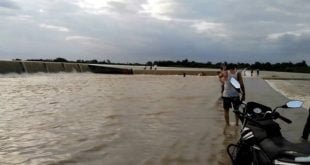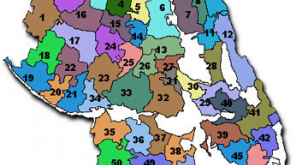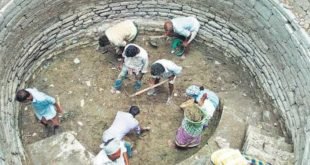Kadapa district is blessed with a series of beautiful valleys through which holy rivers like Pinakini (Pennar), Papaghni, Chitravathi, Mandavya, Cheyyeru cut across the district giving the land sanctity of their own.
The river Penna is the most important river flowing right through the District whose legend is incorporated in a sasanam (inscription) at Gandikota.
The Seshachalam range of hills – passes through this district and is crowned ultimately with the holy shrine of Tirumala in Chittoor District (The city of Kadapa is known as the threshold of the shrine of the Lord of Seven hills. In telugu Kadapa means ‘threshhold’, a camping place for the pilgrims visiting the Lord Balaji) forms part of the central portion of Eastern Ghats. The Eastern ghats don’t possess structural continuity. The hill ranges part themselves from the orographical knot, dividing Settigunta reserve forest and the Balapalle reserve forest. Each of these ranges are described below:-
1.Vellikonda Hills: The hills of eastern ghats run north wards going through the eastern boarders of Rajampet, Sidhout and Badvel talukas. The highest peak located at Thollipenta of Rajampet Taluka is said to be about 2710 ft.
2.Palakonda Hills: The second hill range is called the Palakonda hills or Seshachalam hills formed massive quartzites, interbedded with slates and lavas. It is in this range near Vempalle that we have the beautiful gorge called the Vempalle Gandi of Ramayana fame where the river Papaghni cuts through the range.
3.Nallamalais & Lankamalais: The hill range run north wards along the boundary line dividing Kadapa and Sidhout talukas on thence to Proddatur taluka to merge into Kurnool district. The Nallamalais are covered by thick forest and abounding wild animals. The hill ranges average a hight of 2500 to 3000 ft.
4.Yerramalais: The red, granite box bereft of growth present a desolate appearance of red in contrast to the black cotton fields that they over look and because of this they acquired a name of ‘Yerra’.
Thus Kadapa tract is associated with such holy rivers and hills – has been considered a holy land. The soil of the district has been classified into red ferruginous soil and black soil. These two classes can be sub divided into clay, loam sand with finer distinctions.

The forests of the district are of a dry deciduous type and are very open and have a luxuriant undergrowth of grass.The over all condition of the forest in the district is not very good. The dominant and most valuable tree is Pterocarpiis santalinus (Red sanders— Chandaiiatn). It is a very pretty, moderate-sized tree, with an upright clean bole and rounded crown. The wood is dark claret red in colour, and is extremely valuable. The red sanders, or “redwood” tree as it is also called, deserves more than passing mention, as it is said that there is probably no important Indian tree the distribution of which is so limited in range. Since this is the only district of the country in which this species occurs, a positive conserve and extend them has been evolved. These forests fall under three zones wise those of Teral or Fuel Forests upto an elevation of hundred feet, Hill Forests or Red Sanders lying between the elevation of 800 and 2000 feet and Shoreaeugenla occupying elevations above 2000 feet.
The two great classes of evergreen scrub and deciduous forest are found here as elsewhere. The former, which is confined to the bottom and sides of ravines and to moist localities at the foot of the hills, comprises the following among its principal trees and shrubs. The description of these trees and shrubs is taken from Gamble’s “Manual of Indian Timbers”:
Diospyros chloroxylon (Ullinda): A large shmb or small tree, useful for fuel.
Maha huxifolia (Uti): A small tree, useful for fuel.
Erythroxylon tnofiogy/iiim (Devaddri): A small tree. The wood is strong, hard and pretty but is little used except for fuel. The leaves are said to be eaten in famine seasons.
Mimusops Indica (Pala) and Hexandra (Pogada) — Fine large trees. Wood is very hard and heavy, and is valued as fuel. The fruit is edible. The bark is used for native medicinal purposes. The wood can be used as timber, but its great weight and hardness and the existence of better timber trees are against it in this respect.
StrycJuios nux-vomica (Mushti): A moderate-sized tree or shrub. Leaves, bark, fruit and especially the seeds are poisonous. The latter yield alkaloids, strychnine and brucine. With two exceptions the tree is untouched by animals. The Langur monkey is able to eat even the seed with impunity, while the goat occasionally browses and may even make a hearty meal off the very young shoots.
Strycluws potatorum (Chilla): A moderate-sized tree. Not poisonous. The seeds are used to clear muddy water by rubbing the inside of the vessels with them. It is known as “clearing nut” tree. The pulp of the fruit is edible and is made into preserve. The wood is good and is used for
ploughs, building purposes and cart wheels.
Eugenia jambohina (Neredu): A good timber tree, useful for building timber and also for agricultural implements. The bark is used in native medicine as a specific for dysentery.
Pterospcrmnm suhcrifoUiini (Tada): A moderate-sized tree. The wood is used chiefly for fuel but also for making carts.
Sapindiis emarginatus (Kunkudu): A large tree. The fruit is used for washing as a substitute for soap, and is known as the “soap nut.” The wood is good but is not much used.
Vitex altissima (Nemaliadugn): A good timber tree used in building and cart-making.
Wehera corymbosa (Kommi): A large shrub.
Ixora parviflora (Kiirivi): A shmb. The green branches are used for torches.
Carissa carandas (Kalivi): A shrub. Extremely thorny. The branchesare used for fencing. The wood is used for fuel.
Dodonaa viscosa (Bauddni): A shrub. Its branches are used to support the earth of a flat roof.
Marraya Konigii (Karepaku): A small tree. The wood is used for agricultural implements. The leaves are used to flavour curries.
This tract has also been identified as the forest of Dandaka through which the god king Sreerama and his consort Seetha wandered during their 14 years of exile.
 www.kadapa.info Voice of the YSR Kadapa District
www.kadapa.info Voice of the YSR Kadapa District







hey this website is great. I’m glad I came by this blog. Maybe I can contribute in the near future.
Good and informative website on kadapa! Also your web site so much up very fast! What host are you using? I wish my website loaded up as quickly as yours…